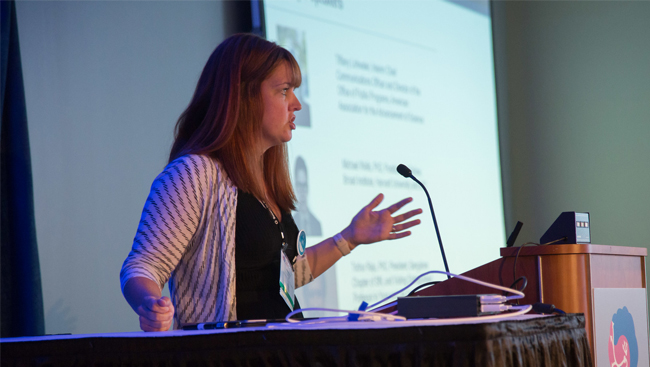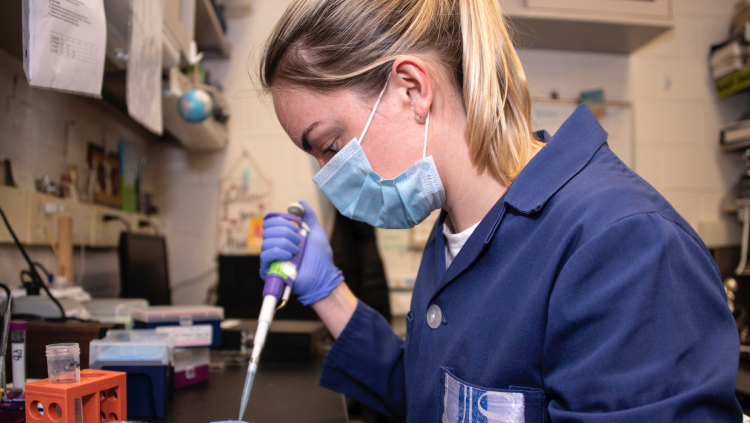
“In my career, I spent a long time educating undergraduate students, and what I realized is I was teaching my students how to communicate with scientists, by writing scientific papers — but what I hadn't done was teach them how to talk about science to people who weren't scientists,” says Jennifer Yates, assistant director of the Innovation in Learning Center at the University of South Alabama.
Yates’ story isn’t an anomaly in the scientific community. That’s why stories like hers illustrate the importance of creating a culture within training programs that prioritizes sharing science with nonscientists and teaching students how to do that effectively.
Sharing science is a form of advocacy and a simple way to contribute to the field beyond your individual research. Yates got her start in science communication as a former member of SfN’s Public Education and Communication Committee, which guides SfN’s initiatives and programs to educate the public and educators alike about neuroscience.
“After that, I started getting my students to think about how, now that they're becoming scientists, they’re going to tell people about that science,” she says.
“Most scientists have a passion for sharing their science, but they’re fearful because they don't know what words to use or how to talk to nonexperts,” says Lori McMahon, director of the Comprehensive Neuroscience Center and a professor at the University of Alabama at Birmingham (UAB), and a member of SfN’s Government and Public Affairs Committee. “Giving them the tools is critical.”
Here are four lessons for improving students’ science communication skills and helping them share science with others.
1. Tell your story.
Every neuroscientist has a story to tell about why they’re passionate about neuroscience. Think back to what it was that made you care about it, and share that.
“There's nothing more compelling than the story of your own journey — of your own research and innovation — to get a conversation started and show the importance of what you do,” says Yates.
“As scientists, we're passionate about what we're doing, and we understand why it's important. But just because we're passionate about it doesn't mean a nonexpert understands why it matters. It's our job to tell them,” says McMahon.
2. Connect on a personal level to explain why basic research is important.
A part of the story scientists have to tell is the importance of making discoveries in basic science on which future studies — sometimes with the capacity to change lives — can expand.
“It's just as important to fund NIH and clinical research as it is to fund NSF, which typically focuses on more basic research. You can't get to the medical aspects without having done that foundational work,” explains Yates.
When communicating this message to the people who decide how to appropriate funds, try to connect to their humanity by invoking the values and experiences you share.
“Politics don't matter. It matters that these are concerns about the human condition,” says Yates. “We all care about the brain. We all have a family member or know someone who has a family member with Alzheimer's or epilepsy or whatever the case might be. Use those stories to help the people making these important decisions think about — and care about — the applications of those funds.”
3. Put your science in context.
Especially if you have a meeting on Capitol Hill, explain that your research is only one part of the body of research being conducted, and for all of those studies to work independently, build on one another, and collectively advance the field, science needs funding.
According to Yates, “That's the way to simplify your message and really engage the people you’re meeting with on the Hill.”
If you’re meeting with a policymaker on the Hill, ask advocacy@sfn.org for resources to help you prepare. You can also request to talk or practice your pitch with SfN staff.
4. Practice to overcome fear.
Like anything, talking about your science becomes easier with practice. Start by talking to family members, and once you’re comfortable, move on to neighbors or friends outside of the field.
McMahon recommends this exercise: Explain what each scientist in your laboratory or clinical research does, what it is you’re trying to understand, and why it matters to the person you're speaking to. Ask yourself why they should care about the problem you're trying to solve.
In addition, you can help students refine their communication skills by encouraging them to participate in advocacy and outreach events, or by starting a program, like UAB’s Discoveries in the Making. McMahon requires her students to participate in this program, which provides a venue for graduate students and postdocs to make their findings available to the public.
“They're on their way to making discoveries. That’s exciting, and this program gives them the means to strengthen the skills they need to communicate that,” she says, noting that above all else, “It's about building the culture.”
Discover best practices and SfN’s advocacy resources at sfn.org/advocacy. For more information, reach out to advocacy@sfn.org.
Speakers







